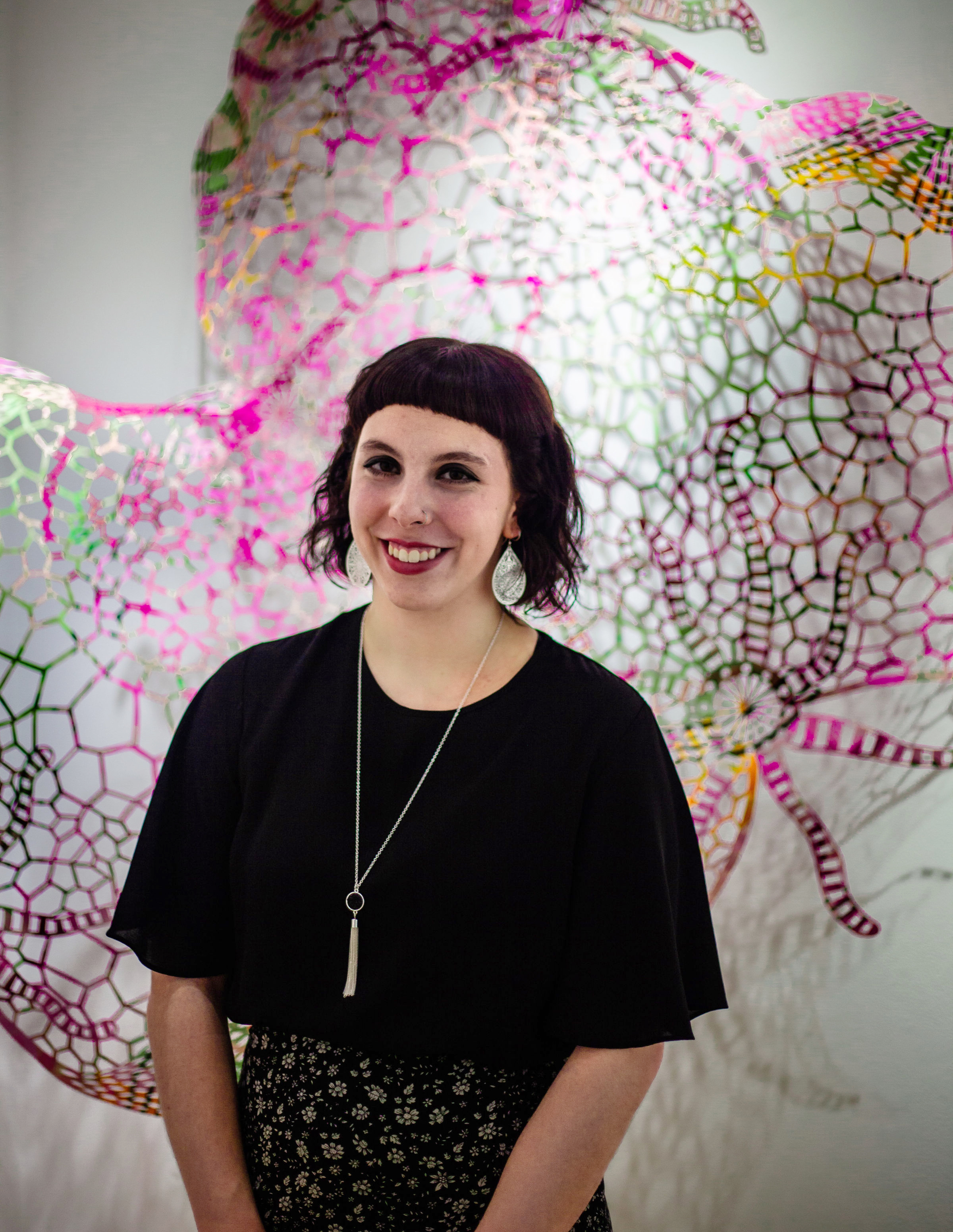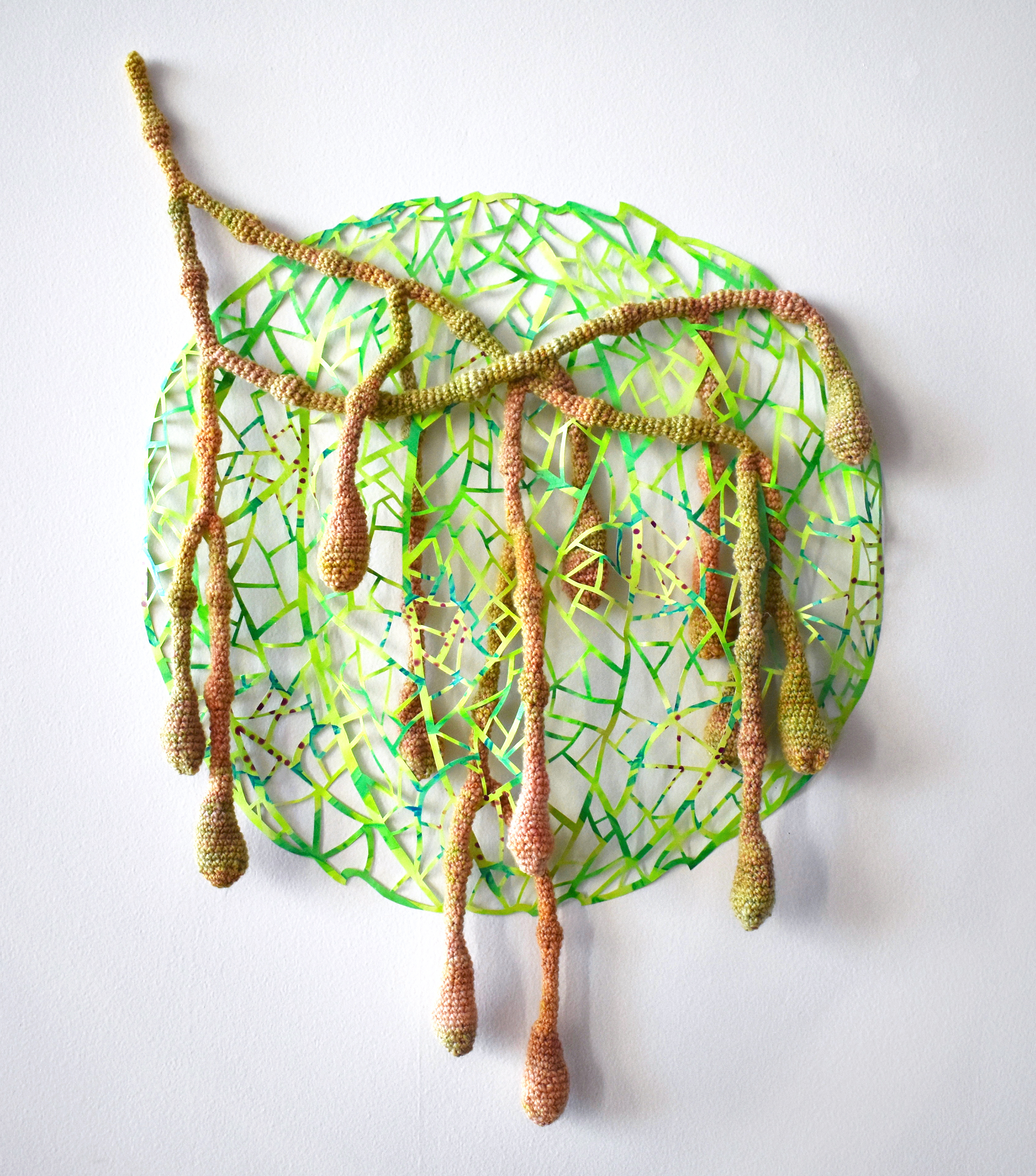
Emily Brodrick, Courtesy of Kristin Higgeins https://www.kristenhigginsphotography.com/
One can only gasp when you take it all in. Hidden in the nondescript middle gallery of the Kingston Gallery, is a true wonder; a virtuoso ode to nature, memory, craft, and longing. Taking on an ethereal quality, the work in What We Choose to Keep transports the viewer to alien worlds, childhood forests, cold evenings spent with loved ones. The exhibition forces each art-goer to come to terms with not only their sense of nature and memory, but also the dualities that can occupy one’s mind.
On the left wall are three pieces: Flower Vase No. 1, Flower Vase No. 2, and Interstices. The two flower vases are underglaze ceramics that serve well to anchor the space. Dense and decidedly low-brow, they immediately exhibit Brodrick’s range. As the eye drifts to the right, Interstices comes into view. Exhibiting prodigious collaging skill, the vibrant piece pulls you in to examine the detail, the relentless patterns, and the careful composition that is a hallmark of Brodrick’s work. Interstices serves as a paragon of the transformation undertaken by traditional craft supplies to create high concept artwork.
In the middle gallery sits Vine, the largest piece in both volume and stature. The dreamy canopy enveloped the wall, utilizing natural forms and eclectic (but strong) palettes that brought a feeling of nostalgia in a way that I was not prepared for. The tendrils of the piece, executed with machine-like precision and devotion to craft, glided above the space, wiggling and moving with the faintest of breeze from the AC/Heater. As this piece reached towards the heavens, Interfuse, displayed on the right, brought me back towards earth. Interfuse immediately looks familiar and recognizable, achieved by applying natural forms evocative of the hives and honeycombs of bees, the floppy flower crowns you made as a kid, and the riches of a youth spent in the bosom of nature. The shrine to those adventures among the mosses and trees, although large in volume, does not envelope like Vine; but simply floats. It almost transcends the space, as if taken from somewhere far away and calmer—a place with natural light tracing the shadows of painstaking patterns, a place to celebrate this work’s gravitas.
Tucked in the corner of this space is a smaller piece, Collect. This piece seeks to connect to its larger cousins on the facing wall, thoughtfully placed in the offset bottom left of the wall panel, the spaceseaweed is both playful and technical, with a myriad of geometric complications that turn this work into what I can imagine was a nightmare of paper and razor blades. Collect sits vigil to Duality, a piece at once technically awe-inspiring as well as fundamentally different than the earlier works. Duality is truly an ode to crafting. Brodrick let me know that the patterns on display in this work are traditional crochet patterns, repurposed in a palette that felt as close to earth (or the hearth) as could be. The juxtaposition of natural vs. built, kitschy vs. austere, and High Art vs. low-brow are all culminated in this piece. These archetypal patterns from the world of fiber further inform the other pieces, illuminating the consistency of the artworks previously viewed.
A final piece entitled Interwoven feels like the culmination of all of the concepts, ideas, and techniques that are on display. A round form, executed in a strong green unmistakably referencing the forest, is intersected by handspun(!) yarn. The oozing that is achieved is both primordial and fresh. This piece is truly of the earth, and as the sap hangs low, the tactility of the piece begs to be touched. This is the shrine from which the memories of long summers and still nights will spring. Interwoven feels sentimental but confident, a showcase of both origin and many years of dedicated study.
The intentionality of every cut and glue seemed to only intensify this feeling of nostalgia. When does a memory stop anchoring you where you came from? When does memory become a dream? As I gazed into the patterns of Interwoven, I thought of living more intentionally, of calling a loved one and of walking barefoot through the forest while listening to Enya. Step outside, and soak up the memories, shrines, and talismans of Emily Brodrick’s mind.
What We Choose to Keep will be on view at Kingston Gallery (450 Harrison Ave, No. 43) until February 24th. Gallery hours are Wed-Sun 12-5pm, and a closing reception will be held on the afternoon of the 24th from 3 to 5 pm. More info can be found here.



